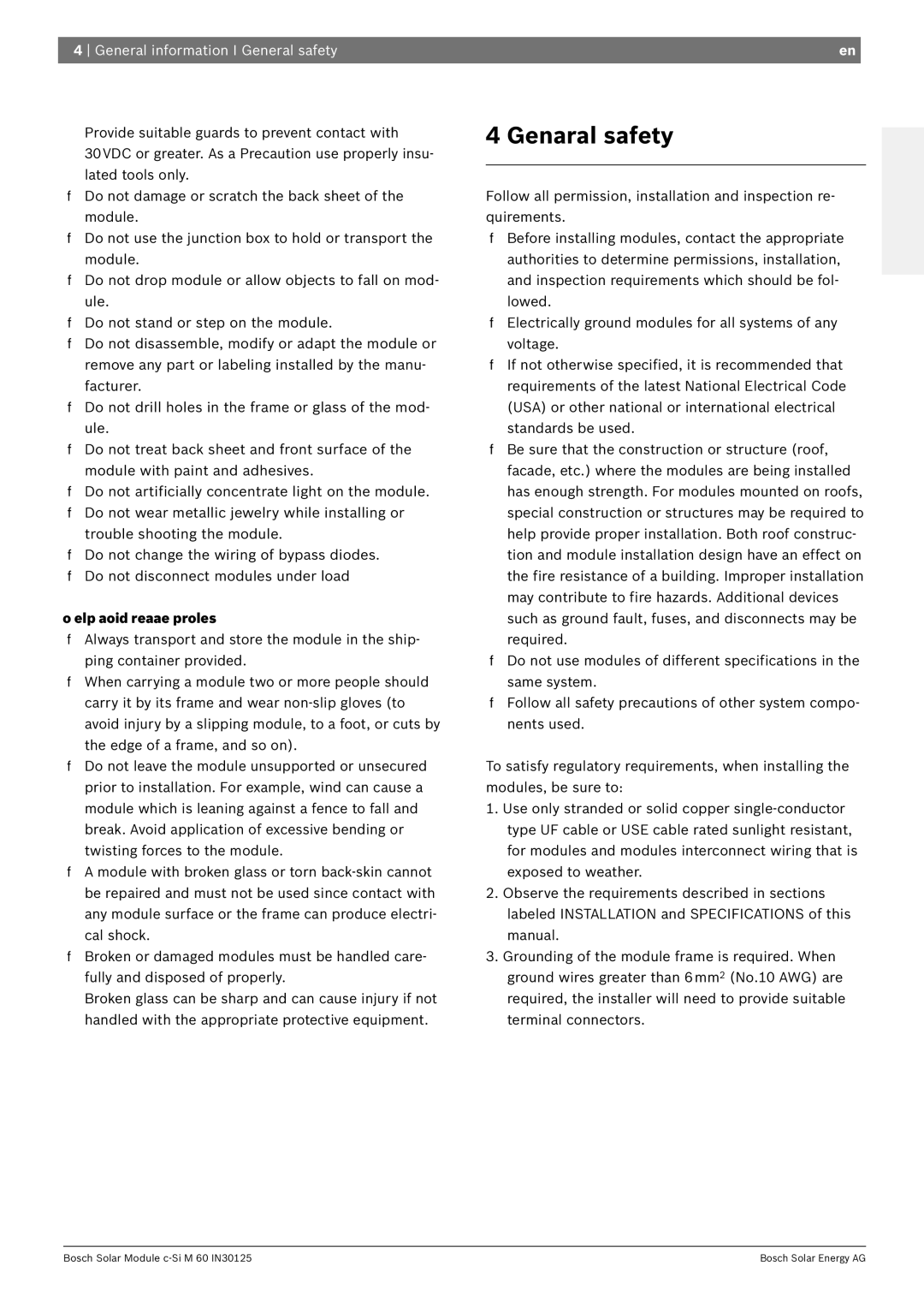Provide suitable guards to prevent contact with 30 VDC or greater. As a Precaution use properly insu- lated tools only.
Do not damage or scratch the back sheet of the module.
Do not use the junction box to hold or transport the module.
Do not drop module or allow objects to fall on mod- ule.
Do not stand or step on the module.
Do not disassemble, modify or adapt the module or remove any part or labeling installed by the manu- facturer.
Do not drill holes in the frame or glass of the mod- ule.
Do not treat back sheet and front surface of the module with paint and adhesives.
Do not artificially concentrate light on the module.
Do not wear metallic jewelry while installing or trouble shooting the module.
Do not change the wiring of bypass diodes.
Do not disconnect modules under load
To help avoid breakage problems
Always transport and store the module in the ship- ping container provided.
When carrying a module two or more people should carry it by its frame and wear non-slip gloves (to avoid injury by a slipping module, to a foot, or cuts by the edge of a frame, and so on).
Do not leave the module unsupported or unsecured prior to installation. For example, wind can cause a module which is leaning against a fence to fall and break. Avoid application of excessive bending or twisting forces to the module.
A module with broken glass or torn back-skin cannot be repaired and must not be used since contact with any module surface or the frame can produce electri- cal shock.
Broken or damaged modules must be handled care- fully and disposed of properly.
Broken glass can be sharp and can cause injury if not handled with the appropriate protective equipment.
4 Genaral safety
Follow all permission, installation and inspection re- quirements.
Before installing modules, contact the appropriate authorities to determine permissions, installation, and inspection requirements which should be fol- lowed.
Electrically ground modules for all systems of any voltage.
If not otherwise specified, it is recommended that requirements of the latest National Electrical Code (USA) or other national or international electrical standards be used.
Be sure that the construction or structure (roof, facade, etc.) where the modules are being installed has enough strength. For modules mounted on roofs, special construction or structures may be required to help provide proper installation. Both roof construc- tion and module installation design have an effect on the fire resistance of a building. Improper installation may contribute to fire hazards. Additional devices such as ground fault, fuses, and disconnects may be required.
Do not use modules of different specifications in the same system.
Follow all safety precautions of other system compo- nents used.
To satisfy regulatory requirements, when installing the modules, be sure to:
1.Use only stranded or solid copper single-conductor type UF cable or USE cable rated sunlight resistant, for modules and modules interconnect wiring that is exposed to weather.
2.Observe the requirements described in sections labeled INSTALLATION and SPECIFICATIONS of this manual.
3.Grounding of the module frame is required. When ground wires greater than 6 mm2 (No.10 AWG) are required, the installer will need to provide suitable terminal connectors.
4.Under normal conditions, a photovoltaic module is likely to experience conditions that produce more current and/or voltage than reported at Standard Test Conditions. Accordingly, the values of Isc and Voc marked on this module should be multiplied by a factor of 1.25 when determining component voltage ratings, conductor capacities, fuse sizes, and size of controls connected to the PV output.
5.Refer to section 690-8 of the National Electric Code (NEC) for an additional multiplying factor of 125 % (80 % de-rating) which may be applicable.
6.Conductor recommendations: single conductor cable, type USE-2 12 AWG, rated 600 V/1000 V minimum, 90° C minimum, marked sunlight resistant.
5Installation
 Important Notice!
Important Notice!
General
Please read this guide completely before installation or use of the modules. This section contains electri- cal and mechanical specifications needed before using your Bosch Solar Energy AG PV modules.
Modules should be firmly fixed in place in a manner suitable to withstand all expected loads, including wind and snow loads. Module mounting holes are provided for easy installation and proper mechanical loading.
Modules should be mounted with the orientation and tilt angle required for consistent performance (sea-
sonally, yearly). The location should be selected to have direct access to sunlight from 9:00a.m. to 3.00p.m. on the shortest day of the year. Calculate the tilt angle by using the site latitude plus 20 de- grees, with modules facing south in the northern latitudes and north in the southern latitudes. This will result in consistent energy output throughout the year.
The appropriate material should be used for mount- ing hardware to prevent the module frame, mounting structure, and hardware itself from corrosion.
Install modules where they are not shaded by obsta- cles like buildings and trees.
Especially pay attention to avoid partially shading the modules by objects during the daytime.
For roof mounted systems, provide adequate rear ventilation under a module for cooling (100 mm: 4in gap minimum)
Clearance of 7mm: 0.25” or more between modules is required to allow for thermal expansion of the frames.
Observe the specifications for mounting areas ac- cording to Illustrations 1 and 2.
Attachment with clamps on the narrow sides of the solar module may not be performed.
The attachment of the solar module can be per- formed with clamps (or as an alternative, directly on the installation holes). When clamping systems are used, the clamp surface per attachment point on the module must amount to at least 400 mm².
Position of the installation drill holes in accordance with Illustrations 3
Please contact your Bosch Solar Energy AG authorized representative with questions regarding
mounting profiles for modules.

